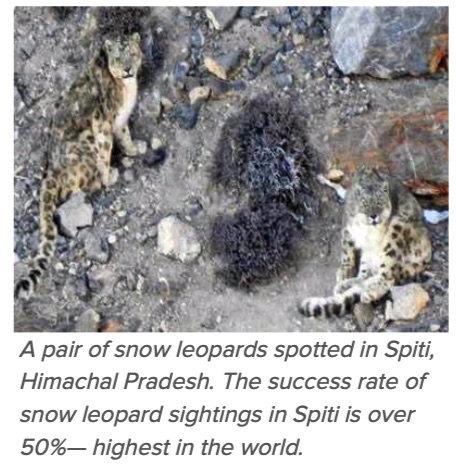Snow leopards: India
This is a collection of articles archived for the excellence of their content. |
Contents |
Population and habitat
As in 2014

See graphic:
Some facts, Snow Leopard: India
Spiti
2019: at 50%, highest rate in world
March 5, 2019: The Times of India

From: March 5, 2019: The Times of India
The elusive and rarely sighted snow leopard is now frequently being spotted in snow-bound Spiti valley of Himachal Pradesh. What will delight wildlife lovers even more is the tendency of the endangered species to be seen in pairs.
Spiti is fast becoming a sought-after destination for Indian and foreign tourists alike. The big cat is now an added attraction.
It has found a safe haven in Spiti where residents are protecting it and have learned to live with it. The success rate of snow leopard sightings in Spiti is over 50 % which is the highest in the world. Elsewhere, wildlife lovers spend decades searching for this elusive animal.
“In the last few days, we spotted two pairs of snow leopard in Spiti .This is a welcome sign suggesting that the species is thriving here,’’said Spiti wildlife range officer Devender Singh Chauhan. Red fox, Himalayan tahr, woolly hare, Himalayan blue sheep and many other species also have significant populations here added Chauhan. He said with the valley having received heavy snow this season, wildlife is descending to the lower regions. With the increasing sightings of the snow leopard, Chauhan added wildlife department has started to run snow leopard conservation programmes in Spiti and the results have been outstanding. Chauhan added that the economy of the village too has got a major boost with the sightings of the big cats.
A large number of visitors are now ready to pay money to the villagers who in turn are ready to help them visit places where the snow leopard could be sighted. “This is because of the environment that this animal is thriving in, in Spiti,’’ added wildlife range officer.
The valley already has an unwritten law banning poaching and residents respect this creature, said Chauhan.
Uttarakhand
2022
Pankul Sharma, Oct 23, 2022: The Times of India
Dehradun : In welcome news on International Snow Leopard Day, count of the elusive cat, also known as ‘Ghost of the Himalayas’, has risen to 121 in Uttarakhand now from 86 in 2016, said principal conservator Sameer Sinha.
Sinha added: “If we compare Uttarakhand’s latest count with a 2016 study, we have reason to be happy. The census has been done in a scientific way for the first time. And the International Union for Conservation of Nature has now downgraded the snow leopard population from ‘endangered to vulnerable’. ”
Incidentally, the snow leopard census is being officially done for the first time in India. It began in 2019. While enumeration for Uttarakhand is complete, it’s still on in other parts of the trans Himalayan region such as Leh, Ladakh and Himachal Pradesh.
Regional warden of Leh-Ladakh, Mohd Sajid Sultan, said “Since the high-altitude area here (Leh-Ladakh) is vast, over 45,000sqkm, it will take a while longer. We have covered over 70% of the area. ”
In Uttarakhand, the count was carried out jointly by the state forest department and Wildlife Institute of India along with the Union ministry of environment, forest and climate change. These elusive big cats are at present spotted in only 12 countries of the world, with a total estimate of 3,000 on the lower side and 7,000 on the higher. In 2016, as per unofficial estimate, about516 were detected in India.
“The gap of 4,000 (worldwide) shows how difficult the process (to spot these big cats) are,” Sinha said, adding: “Since these leopards live in a very low density area, decline in its number can be quite rapid”.
Snow leopards are usually found at an altitude of 9,800ft to 17,000ft in the high and rugged terrains. And both Sinha and Sultan said climate change is a major threat to the population. In Himachal, a study conducted last year estimated the count at 73. The study didn’t include cubs though. Earlier, there was an estimate between 62 and 65 in parts of upper Kinnaur and Spiti Valley. Kibber wildlife sanctuary is where snow leopards are mostly found. For these big cats in India, three large landscapes have been identified -Hemis-Spiti in Ladakh and Himachal; Nanda Devi-Gangotri in Uttarakhand, and Khangchendzonga-Tawang from Sikkim to Arunachal.